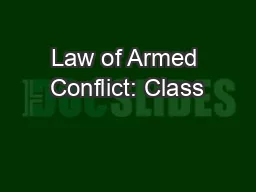

International Conflicts Jus ad Bellum Justice of War Regulates the decision to go to war 1 st Class Governed by UN Charter domestic law Jus in Bello Justice in War Regulates the actions of a State ID: 319869
Download Presentation The PPT/PDF document "Law of Armed Conflict: Class #2" is the property of its rightful owner. Permission is granted to download and print the materials on this web site for personal, non-commercial use only, and to display it on your personal computer provided you do not modify the materials and that you retain all copyright notices contained in the materials. By downloading content from our website, you accept the terms of this agreement.
Slide1
Law of Armed Conflict: Class #2International ConflictsSlide2
Jus ad Bellum (Justice of War)
Regulates the decision to
go to war = 1st Class Governed by UN Charter + domestic lawJus in Bello (Justice in War)Regulates the actions of a State in war Means and Methods; Targeting and Treatment Governed by Hague and Geneva conventionsJus post Bellum (Justice after War)Post conflict resolution – defining a just peace Emerging body of ideas
3 Types of Laws of WarSlide3
Introduction to International Law
Membership “dues” normally require:
Defined TerritoryPermanent PopulationRecognized GovernmentCapacity to Conduct International Relations
Who are
members of the club? Answer = StatesSlide4
Once a Member, you get recognized “rights”
Sovereignty over territory and authority over its
nationals Status as a legal entity (acquire property, make contracts, enter into agreements, join international organizations, etc.)
Can join with other States to make international lawSlide5
But, membership comes at a cost
Inherent Tension
: Sovereignty is the ultimate benefit of statehood. Inherent to sovereignty is freedom from outside interference. International law, however, seeks to regulate State conduct. States “trade” aspects of sovereignty in order to reap the benefits of the international legal system.Slide6
Principle Sources of LOAC
Consistent state practice + sense of legal obligation
(opinio juris)Don’t need 100% agreement Still Binding on all states unless Persistent ObjectorCan’t object to Jus Cogens
universally accepted norms
genocide, slave trade, torture
LOAC
International
Agreements/Treaties
Customary
International Law
Treaties:
Hague
(
Means and
Methods of war)
Geneva
(
Respect and
Protect victims of war)
Additional Protocols I and
II (blurring of Hague and Geneva)Slide7
S. v PetaneSlide8
Scenario
Over 48,000 people have been killed in Country X as a result of fighting and violence; over 5,300 have been kidnapped
The insurgents, with numbers estimated at 100,000, are establishing their own form of government in sections of Country X, levying taxes against the people, and regulating traffic in certain areasCountry X has been engaged in a “mortal combat” with “insurgents” for over five yearsCountry X is battling the insurgents with police and with over 40,000 members of its armed forces – the US has been asked to send in advisors to assist
The insurgents often wear uniforms and fight with military-grade weaponsSlide9
Where is this?
Is this armed conflict? If so, what type of conflict is this? International? Non-International?
What laws apply? What protections apply for the government forces? What protections apply for the members of the drug cartels?Mexico
“It’s a real war… We’re not faking. ”
- Major of Tijuana
“There really is an armed conflict in Mexico. There really is a war.”
Mexico City Journalist
Jan 2012Slide10
Ripped from the Headlines…
01/15/12: The
Miami Herald reports that Russia's Foreign Ministry has accused the US of breaking international law by keeping terror suspects in indefinite custody without trial at Guantanamo Bay. The ministry says the prison and authorizing indefinite detention represents a "flagrant violation of international law“ and
contradicts US obligations under international humanitarian law
.
01/17/12: The
Washington Times
published an article entitled: “
Bureaucracy Killing U.S. Troops In Afghanistan: Political Correctness Keep Army
Medevac
Helicopters Grounded” arguing that
Army regulations requiring that
Medevac
helicopters abide by the Geneva Convention should not be followed
in our current conflict in Afghanistan.Slide11
Contrasting Int. Human Rights Law (IHRL)
vs. LOAC
Obligations on individualsSpecific principlesEnunciates individual and state responsibilities No state derogationProtections linked to nationalities or specific statuses (like combatants)
vs
IHRL
LOAC
Citizens hold individual rights that their state respects
General principles
Enunciates state responsibilities
Allows for state derogation
Rights given to allSlide12Slide13
Treaty-Based Law of War
Key LOW Treaties:
Hague IV: 43 partiesGeneva Conventions (I-IV): 194 partiesUN Charter: 192 parties*Additional Protocol I: 170 parties*Additional Protocol II: 165 parties*Ottawa (landmines): 156 parties*Rome Statute (ICC): 114 parties*Dublin (cluster bombs): 49 parties *US not a partyThe LOW (governing IAC) is Highly CodifiedSlide14
The Hague
Everyone
has to be a “contracting party” them to apply to anyoneSlide15
Common Article 2
“If, in time of
war, a belligerent is not a party to the Convention, its provisions shall, nevertheless, be binding as between all the belligerents who are parties ~ Article 25Cf. 1929 Geneva ConventionsSlide16
Classification and Triggers
Issue: What law applies?
“Right type of conflict?” Four possibilities: International (interstate) armed conflictWars of national liberation in pursuit of the right of self-determinationNon-international (internal) armed conflictPeacetime disturbances (riots, banditry…)BackgroundSlide17Slide18Slide19
Non-International Armed Conflict
Common Article 3
State v. Insurgent or Non-StateOnly CA 3 applies
Not full body of GC
“Mini-convention”
No Prisoners of
War
No Combatant Privilege
Domestic Law applies
Pictet
: Armed Conflict:
1) organized military force?
2) subject to some authority?
3) control territory?
4) Respect the law of war?
4) Does the State respond with regular armed forces?Slide20
Classification and Triggers
Issue: What law applies?
“Right type of conflict?” Four possibilities: International (interstate) armed conflictWars of national liberation in pursuit of the right of self-determinationNon-international (internal) armed conflictPeacetime disturbances (riots, banditry…)Slide21